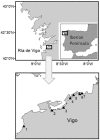First Report of Paralytic Shellfish Toxins in Marine Invertebrates and Fish in Spain
- PMID: 33227958
- PMCID: PMC7699195
- DOI: 10.3390/toxins12110723
First Report of Paralytic Shellfish Toxins in Marine Invertebrates and Fish in Spain
Abstract
A paralytic shellfish poisoning (PSP) episode developed in summer 2018 in the Rías Baixas (Galicia, NW Spain). The outbreak was associated with an unprecedentedly intense and long-lasting harmful algal bloom (HAB) (~one month) caused by the dinoflagellate Alexandrium minutum. Paralytic shellfish toxins (PSTs) were analyzed in extracts of 45 A. minutum strains isolated from the bloom by high-performance liquid chromatography with post-column oxidation and fluorescence detection (HPLC-PCOX-FLD). PSTs were also evaluated in tissues from marine fauna (invertebrates and fish) collected during the episode and in dolphin samples. The analysis of 45 A. minutum strains revealed a toxic profile including GTX1, GTX2, GTX3 and GTX4 toxins. With regard to the marine fauna samples, the highest PSTs levels were quantified in bivalve mollusks, but the toxins were also found in mullets, mackerels, starfish, squids and ascidians. This study reveals the potential accumulation of PSTs in marine invertebrates other than shellfish that could act as vectors in the trophic chain or pose a risk for human consumption. To our knowledge, this is the first time that PSTs are reported in ascidians and starfish from Spain. Moreover, it is the first time that evidence of PSTs in squids is described in Europe.
Keywords: Alexandrium minutum; HABs; PSP; PSTs; Ría de Vigo; invertebrates; non-traditional vectors; northwest Iberian Peninsula; paralytic shellfish toxins.
Conflict of interest statement
The authors declare no conflict of interest. The funders had no role in the design of the study; in the collection, analyses, or interpretation of data; in the writing of the manuscript, or in the decision to publish the results.
Figures



Similar articles
-
Paralytic Shellfish Toxins in Surf Clams Mesodesma donacium during a Large Bloom of Alexandrium catenella Dinoflagellates Associated to an Intense Shellfish Mass Mortality.Toxins (Basel). 2019 Mar 29;11(4):188. doi: 10.3390/toxins11040188. Toxins (Basel). 2019. PMID: 30934869 Free PMC article.
-
Change in Paralytic Shellfish Toxins in the Mussel Mytilus galloprovincialis Depending on Dynamics of Harmful Alexandrium catenella (Group I) in the Geoje Coast (South Korea) during Bloom Season.Toxins (Basel). 2020 Jul 7;12(7):442. doi: 10.3390/toxins12070442. Toxins (Basel). 2020. PMID: 32645973 Free PMC article.
-
Hydrophilic interaction liquid chromatography-tandem mass spectrometry for quantitation of paralytic shellfish toxins: validation and application to reference materials.Anal Bioanal Chem. 2017 Sep;409(24):5675-5687. doi: 10.1007/s00216-017-0507-3. Epub 2017 Jul 20. Anal Bioanal Chem. 2017. PMID: 28730312
-
Effects of bioactive extracellular compounds and paralytic shellfish toxins produced by Alexandrium minutum on growth and behaviour of juvenile great scallops Pecten maximus.Aquat Toxicol. 2017 Mar;184:142-154. doi: 10.1016/j.aquatox.2017.01.009. Epub 2017 Jan 20. Aquat Toxicol. 2017. PMID: 28142089 Review.
-
Marine Algal Toxins and Public Health: Insights from Shellfish and Fish, the Main Biological Vectors.Mar Drugs. 2024 Nov 10;22(11):510. doi: 10.3390/md22110510. Mar Drugs. 2024. PMID: 39590790 Free PMC article. Review.
Cited by
-
Determining toxins and harmful contaminants in starfish for future application as organic fertilizer and animal feed.Environ Sci Pollut Res Int. 2025 Apr;32(20):12221-12235. doi: 10.1007/s11356-025-36430-3. Epub 2025 May 7. Environ Sci Pollut Res Int. 2025. PMID: 40332712 Free PMC article. Review.
-
The ciliate Euplotes balteatus is resistant to Paralytic Shellfish Toxins from Alexandrium minutum (Dinophyceae).Water Res X. 2024 Jun 12;23:100229. doi: 10.1016/j.wroa.2024.100229. eCollection 2024 May 1. Water Res X. 2024. PMID: 39099803 Free PMC article.
-
Liza ramada Juveniles after Exposure to the Toxic Dinoflagellate Vulcanodinium rugosum: Effects on Fish Viability, Tissue Contamination and Microalgae Survival after Gut Passage.Toxins (Basel). 2022 Jun 10;14(6):401. doi: 10.3390/toxins14060401. Toxins (Basel). 2022. PMID: 35737062 Free PMC article.
-
Current Trends and New Challenges in Marine Phycotoxins.Mar Drugs. 2022 Mar 8;20(3):198. doi: 10.3390/md20030198. Mar Drugs. 2022. PMID: 35323497 Free PMC article. Review.
-
The Common Sunstar Crossaster papposus-A Neurotoxic Starfish.Mar Drugs. 2021 Dec 7;19(12):695. doi: 10.3390/md19120695. Mar Drugs. 2021. PMID: 34940694 Free PMC article.
References
-
- Martínez A., Garrido-Maestu A., Ben-Gigirey B., Chapela M.J., González V., Vieites J.M., Cabado A.G. Marine biotoxins. In: Kim S.-K., editor. Springer Handbook of Marine Biotechnology. Springer; Heidelberg, Germany: 2015. pp. 869–904.
-
- Khora S.S. Marine dinoflagellate associated human poisoning. In: Kim S.-K., editor. Springer Handbook of Marine Biotechnology. Springer; Heidelberg, Germany: 2015. pp. 789–814.
-
- Turner J.T., Tester P.A. Toxic marine phytoplankton, zooplankton grazers, and pelagic food webs. Limnol. Oceanogr. 1997;42:1203–1214. doi: 10.4319/lo.1997.42.5_part_2.1203. - DOI
-
- Shumway S.E., Allen S.M., Boersma P.D. Marine birds and harmful algal blooms: Sporadic victims or under-reported events? Harmful Algae. 2003;2:1–17. doi: 10.1016/S1568-9883(03)00002-7. - DOI
Publication types
MeSH terms
Substances
Grants and funding
LinkOut - more resources
Full Text Sources
Miscellaneous

